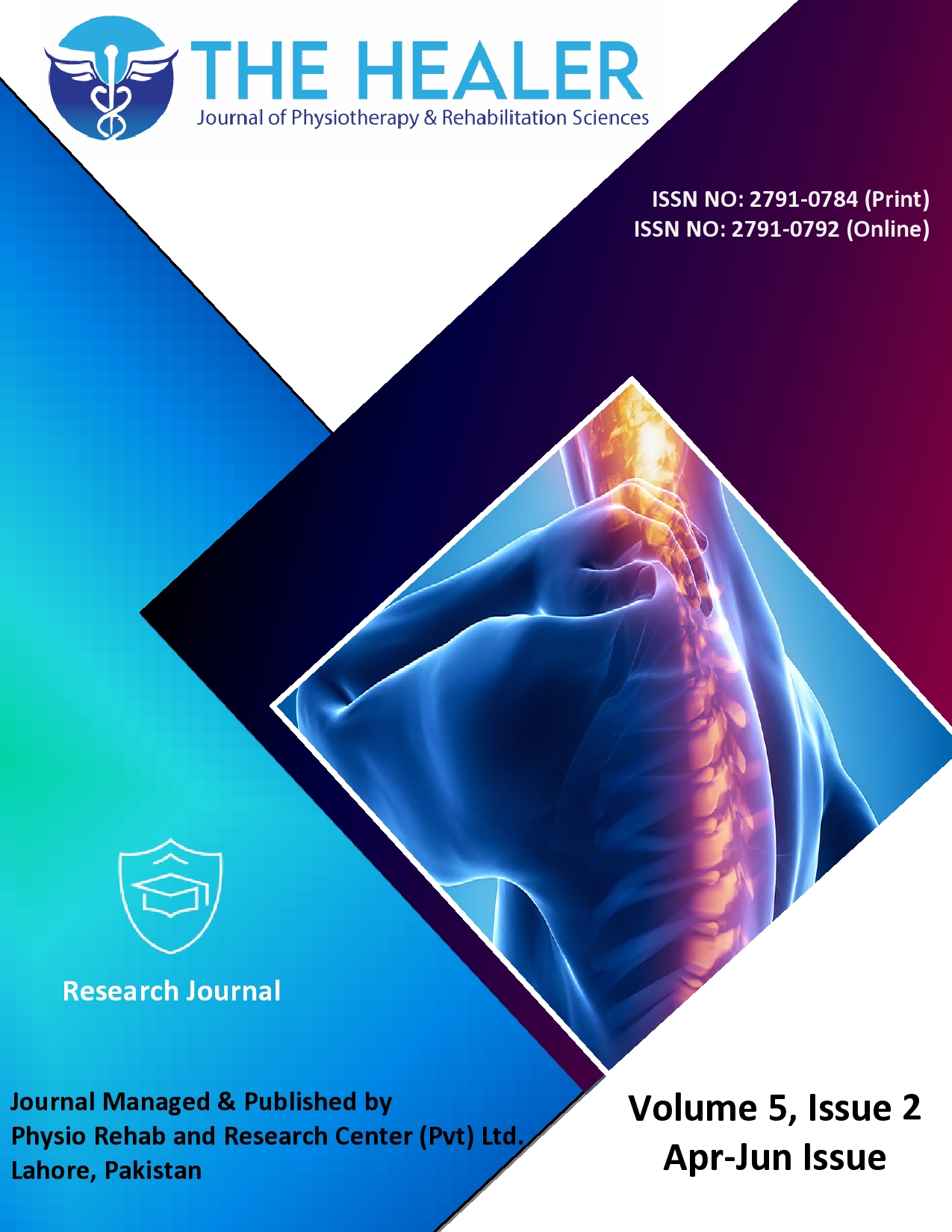Effects of TENS along with Labor Exercises on Pain Intensity in Pregnant Women
DOI:
https://doi.org/10.55735/z5838x61Keywords:
Labor exercises , Numeric pain rating scale, Primigravida women , Transcutaneous electrical nerve stimulationAbstract
Background: Labor pain is usually very severe, especially for first-time mothers, and many women struggle to deal with it. Non-pharmacological methods like transcutaneous electrical nerve stimulation and labor exercises are considered safe and can sometimes reduce the need for medicines. Objective: To assess the effects of TENS, along with basic labor exercises, on pain intensity during labor and to compare it with routine labor care. Methodology: A randomized trial was carried out, and a total of 60 primigravida women in the active first stage of labor were randomly allocated into two equal groups (n=30 each) using a computer-generated randomization sequence. Women with high-risk pregnancies, obstetric complications, pre-existing medical conditions, or contraindications to TENS were excluded. The intervention group received transcutaneous electrical nerve stimulation and selected labor exercises, while the control group received routine labor care only. Labour exercises included upright positions, pelvic rocking, gentle bouncing on a birthing ball, and guided breathing techniques. Pain was checked by using numeric pain rating scale (0-10) before starting the intervention and again after 60 minutes. Participant safety and adherence were monitored throughout the study. Any adverse events, such as skin irritation or fatigue, were promptly addressed. Between-group comparisons for continuous variables were performed using independent t-tests. Repeated measures of pain scores were analyzed using repeated-measures ANOVA. Results: Pain increased as labor moved forward in both groups, but after intervention, the improvement was greater in the intervention group. Their first mean pain score was 6.4 ± 1.1, and in the control group it was 6.3 ± 1.0. After 60 minutes, the pain reduced to 4.9 ± 1.2 in the intervention group, while in the control group it reduced only to 5.8 ± 1.3. This difference after intervention was significant (p<0.05), indicating better pain relief with transcutaneous electrical nerve stimulation and exercises compared with routine care. Conclusion: Transcutaneous electrical nerve stimulation, along with labor exercises, showed better results in reducing labor pain than routine care alone. Since this approach is simple, non-invasive, and safe for mother and baby, it can be considered a helpful method for pain management during the first stage of labor.
Downloads
References
1. Santana LS, Gallo RBS, Ferreira CHJ, et al. Transcutaneous electrical nerve stimulation (TENS) reduces pain and postpones the need for pharmacological analgesia during labour: a randomised trial. Journal of Physiotherapy. 2016; 62(1): 29-34.
https://doi.org/10.1016/j.jphys.2015.11.002
2. Levett KM, Smith CA, Bensoussan A, Dahlen HG. The complementary therapies for labour and birth study making sense of labour and birth - experiences of women, partners and midwives of a complementary medicine antenatal education course. Midwifery. 2016; 40: 124-131.
https://doi.org/10.1016/j.midw.2016.06.011
3. Zuarez-Easton S, Erez O, Zafran N, et al. Pharmacologic and nonpharmacologic options for pain relief during labor: an expert review. American Journal of Obstetrics and Gynecology. 2023; 228(5S): S1246-S1259.
https://doi.org/10.1016/j.ajog.2023.03.003
4. Issac A, Nayak SG, Balakrishnan D, et al. Effectiveness of breathing exercise on the duration of labour: a systematic review and meta-analysis. Journal of Global Health. 2023; 13: 04023.
https://doi.org/10.7189/jogh.13.04023
5. Aslantaş BN, Çankaya S. The effect of birth ball exercise on labor pain, delivery duration, birth comfort, and birth satisfaction: a randomized controlled study. Archives of Gynecology and Obstetrics. 2024; 309(6): 2459-2474.
https://doi.org/10.1007/s00404-023-07115-4
6. Lawrence A, Lewis L, Hofmeyr GJ, Styles C. Maternal positions and mobility during first stage labour. The Cochrane Database of Systematic Reviews. 2013; 10: CD003934.
https://doi.org/10.1002/14651858.CD003934.pub4
7. Rabello RD, Umarani J, Agarwal A. Effectiveness of labor supportive measures on selected maternal physiological parameters, labour pain and maternal satisfaction: a review. Journal of Population Therapeutics and Clinical Pharmacology. 2023; 30(15): 259-270.
https://doi.org/10.47750/jptcp.2023.30.15.028
8. Johnson MI, Paley CA, Howe TE, Sluka KA. Transcutaneous electrical nerve stimulation for acute pain. The Cochrane Database of Systematic Reviews. 2015; 6: CD006142.
https://doi.org/10.1002/14651858.CD006142.pub3
9. Aktaş D, Kolsuz S, Ertuğrul M, Beşirli EG, Gündoğan FR. Effect of birth ball exercising for the management of childbirth pain in Turkish women. Bezmialem Science. 2021; 9(1): 46-52.
https://doi.org/10.14235/bas.galenos.2020.3898
10. Taavoni S. et al. Effect of Pelvic Movements using birth ball and listening to nature sounds and honey syrup consumption on labor pain in nulliparous women: a randomized clinical trial. World Family Medicine. 2018; 16(4): 97-102.
https://doi.org/10.5742/MEWFM.2018.93348
11. Farra HAA, Shalaby HS, Fahmy AA, Nawara M. The safety and efficacy of transcutaneous nerve stimulation (TENS) in reducing vaginal delivery labor pain: randomized controlled clinical trial. Open Journal of Obstetrics and Gynecology. 2020; 10(5): 657-670.
https://doi.org/10.4236/ojog.2020.1050059
12. Haghighi NB, Shayan A, Kazemi F, Zahra M. The Effect of Using Birth Ball on Maternal and Neonatal Outcomes: A Randomized Clinical Trial. Avicenna Journal of Nursing and Midwifery Care. 2017; 25(1): 18-23.
https://doi.org/10.21859/nmj-25013
13. Rani K, Ravi RK, Attri V, et al. Impact of upright position during the first stage of labour on maternal outcomes: a randomized controlled trial. Reviews on Recent Clinical Trials. 2025; 20(1): 52-58. https://doi.org/10.2174/0115748871320194240820202103
14. Dunmez F, Yilmaz T. The effect of using birth ball and squatting position during labor on pain, duration, and satisfaction: A randomized controlled trial. Japan Journal of Nursing Science. 2024; 21(2): e12580. https://doi.org/10.1111/jjns.12580
15. Thuvarakan K, Zimmermann H, Mikkelsen MK, Gazerani P. Transcutaneous electrical nerve stimulation as a pain-relieving approach in labor pain: a systematic review and meta-analysis of randomized controlled trials. Neuromodulation: Journal of the International Neuromodulation Society. 2025; 23(6): 732-746.
https://doi.org/10.1111/ner.13221
16. Báez-Suárez A, Martín-Castillo E, García-Andújar J, et al. Evaluation of different doses of transcutaneous nerve stimulation for pain relief during labour: a randomized controlled trial. Trials. 2018; 19(1): 652.
https://doi.org/10.1186/s13063-018-3036-2
17. Kakar P, Anila M, Khan A, Sindhu S. Evaluating the efficiency of non-pharmacological pain management techniques during labor and delivery. Biological and Clinical Sciences Research Journal. 2023; 4(1): 489.
https://doi.org/10.54112/bcsrj.v2023i1.489
18. Jha S, Vyas H, Nebhinani M, et al. The effect of birthing ball exercises on labor pain and labor outcome among primigraviade parturient mothers at a tertiary care hospital. Cureus. 2023; 15(3): e36088.
https://doi.org/10.7759/cureus.36088
19. Mane SV, Bhatbolan S. Effect of OBG-TENS (transcutaneous electrical nerve stimulation) on labor outcome: a randomized controlled trial. Bulletin of Faculty of Physical Therapy. 2025; 30(1): 32.
https://doi.org/10.1186/s43161-025-00291-1
20. Phalswal U, Jha S, Dixit P, Yadav R. Effectiveness of birthing ball exercises therapy in improving labor pain and labor outcomes: a systematic review. Journal of Family & Reproductive Health. 2024; 18(4): 208-216.
https://doi.org/10.18502/jfrh.v18i4.17409
21. Rani U, Yameen S. Efficacy of lower back massage for improvement of labor pain and patient satisfaction. Biological and Clinical Sciences Research Journal. 2024(1), 1090. https://doi.org/10.54112/bcsrj.v2024i1.1090
22. Deliktas A, Kukulu K. A meta-analysis of the effect on maternal health of upright positions during the second stage of labour, without routine epidural analgesia. Journal of Advanced Nursing. 2018; 74(2): 263-278.

Downloads
Published
License
Copyright (c) 2025 The Healer Journal of Physiotherapy and Rehabilitation Sciences

This work is licensed under a Creative Commons Attribution 4.0 International License.














